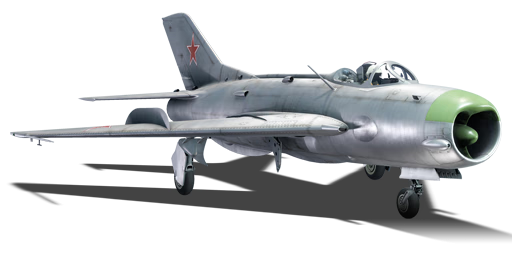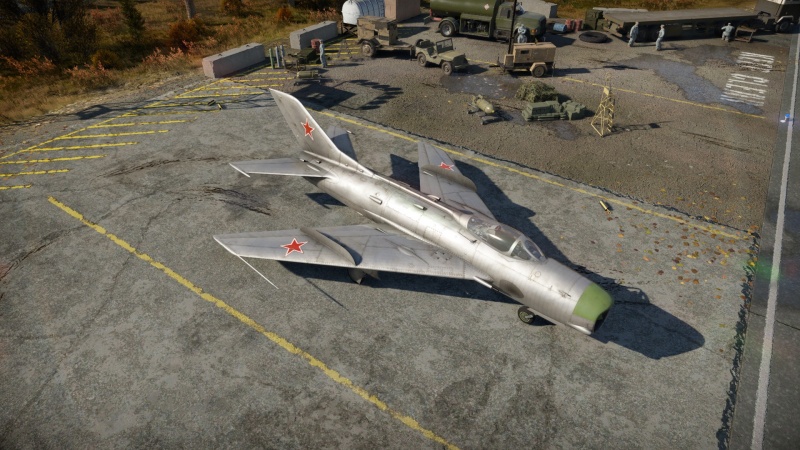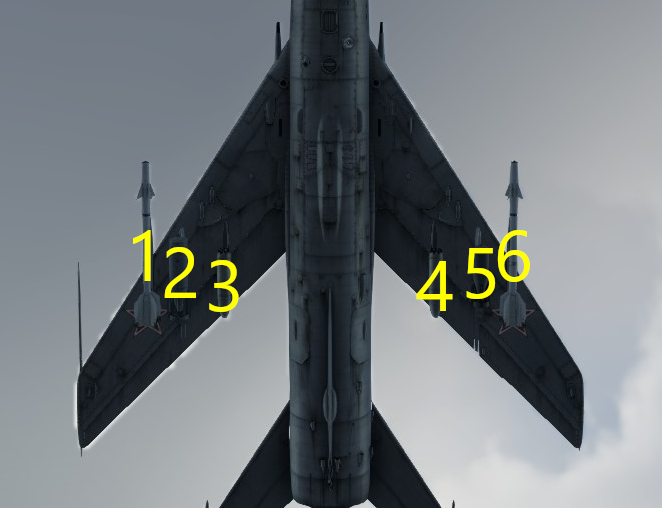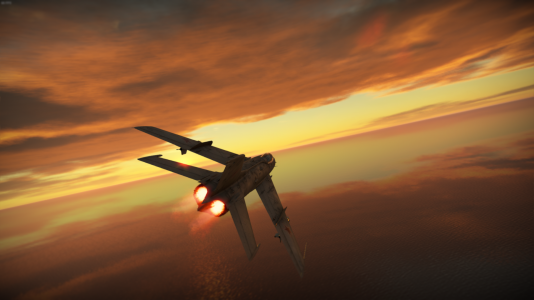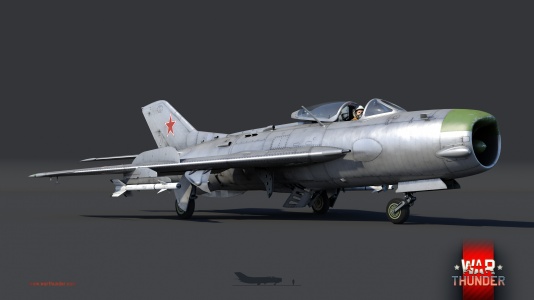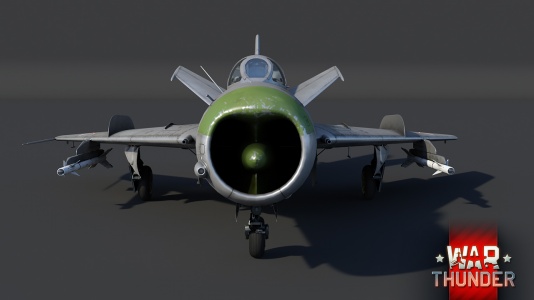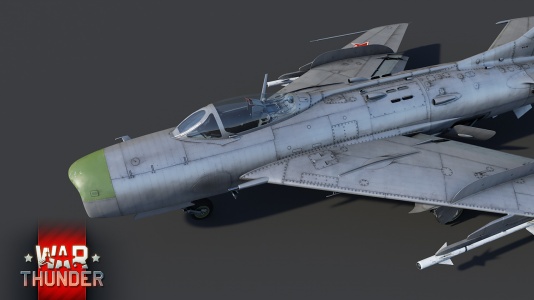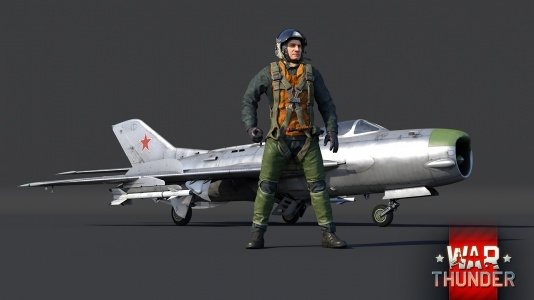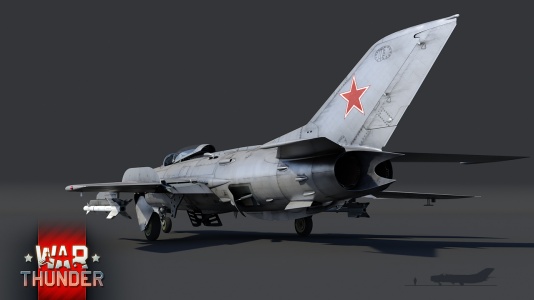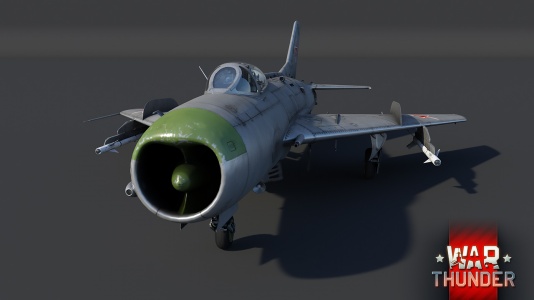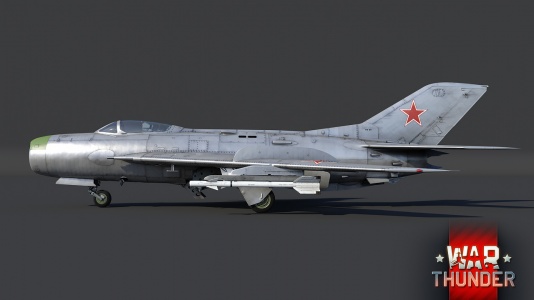Difference between revisions of "MiG-19PT"
(Edits.) |
Colok76286 (talk | contribs) (Edits) |
||
| (47 intermediate revisions by 19 users not shown) | |||
| Line 1: | Line 1: | ||
| − | |||
{{About | {{About | ||
| − | | about = | + | | about = Soviet jet fighter '''{{PAGENAME}}''' |
| − | | usage = | + | | usage = other versions |
| − | | link = MiG- | + | | link = MiG-19 (Family) |
| + | }} | ||
| + | {{Specs-Card | ||
| + | |code=mig-19pt | ||
| + | |images={{Specs-Card-Image|GarageImage_{{PAGENAME}}.jpg}} | ||
}} | }} | ||
== Description == | == Description == | ||
<!-- ''In the description, the first part should be about the history of and the creation and combat usage of the aircraft, as well as its key features. In the second part, tell the reader about the aircraft in the game. Insert a screenshot of the vehicle, so that if the novice player does not remember the vehicle by name, he will immediately understand what kind of vehicle the article is talking about.'' --> | <!-- ''In the description, the first part should be about the history of and the creation and combat usage of the aircraft, as well as its key features. In the second part, tell the reader about the aircraft in the game. Insert a screenshot of the vehicle, so that if the novice player does not remember the vehicle by name, he will immediately understand what kind of vehicle the article is talking about.'' --> | ||
| − | + | The MiG-19 (NATO Code: Farmer) was a Soviet jet designed during the early 1950s. It was a key component of the Soviet Union's air defense plan and served as a vital complement to fighter-interceptor duties. The MiG-19 was known to be a formidable foe in aerial combat due to its reputation for impressive speed, being the first Soviet-produced aircraft to reach supersonic speeds in level flight, and its respectable manoeuvrability. Although the majority of its service in the Soviet Union was spent on routine interceptions, it is best known for its role in the Vietnam War. As its legacy grew, the MiG-19 underwent continuous refinement, giving rise to a diverse range of variants that extended its service life. Among these was the '''{{Specs|name}}''', a single MiG-19P modified to carry the [[R-3S]] "Atoll" missiles, which showcased the aircraft's adaptability and ingenuity. | |
| − | + | ||
| − | The '''{{Specs|name}}''' | + | The '''{{Specs|name}}''' was introduced in [[Update 1.85 "Supersonic"]] and was one of the first three jets to feature guided air-to-air missiles, alongside the [[F-100D]] and the [[Javelin F.(A.W.) Mk.9]]. In the game, it is best known for its manoeuvrability and speed, which allow it to win against many other aircraft in energy fights. However, amidst its impressive capabilities, it remains crucial to note that the {{Specs|name}}'s lack of countermeasures makes it vulnerable to enemy missile attacks, and astute situational awareness is crucial for its survival. |
== General info == | == General info == | ||
=== Flight performance === | === Flight performance === | ||
| − | ''Describe how the aircraft behaves in the air. Speed, manoeuvrability, acceleration and allowable loads - these are the most important characteristics of the vehicle.'' | + | {{Specs-Avia-Flight}} |
| + | <!-- ''Describe how the aircraft behaves in the air. Speed, manoeuvrability, acceleration and allowable loads - these are the most important characteristics of the vehicle.'' --> | ||
| + | The main advantages of the MiG-19PT are its exceptional acceleration, great energy retention in a straight line and the very strong climb rate. Aside from the top speed, the aircraft has the raw performance to at least keep up with more modern jets. | ||
| + | |||
| + | However, the plane is weighed down by its somewhat inferior manoeuvring energy retention, bad low speed manoeuvrability and poor high speed handling. Compression at high Mach numbers slows the roll rate significantly and makes the rudder nearly entirely unresponsive, though MiG-19PT generally has a very responsive elevator. Despite how the acceleration can make up for it, be careful not to turn excessively, as that will bleed much speed due to the poor manoeuvring energy retention. | ||
| + | |||
| + | The performance of the plane doesn't suffer too much when it's stock. It can still out accelerate Phantoms and climb from sea level at 1,100 km/h up to 10 km in a single zoom climb without any modifications. | ||
| − | {| class="wikitable" style="text-align:center" | + | {| class="wikitable" style="text-align:center" width="70%" |
| − | + | ! rowspan="2" | Characteristics | |
| − | |||
| − | |||
| − | ! | ||
| − | |||
! colspan="2" | Max Speed<br>(km/h at 10,000 m) | ! colspan="2" | Max Speed<br>(km/h at 10,000 m) | ||
| − | ! rowspan="2" | Max altitude<br>( | + | ! rowspan="2" | Max altitude<br>(metres) |
! colspan="2" | Turn time<br>(seconds) | ! colspan="2" | Turn time<br>(seconds) | ||
| − | ! colspan="2" | Rate of climb<br>( | + | ! colspan="2" | Rate of climb<br>(metres/second) |
| − | ! rowspan="2" | Take-off run<br>( | + | ! rowspan="2" | Take-off run<br>(metres) |
|- | |- | ||
| − | ! AB | + | ! AB !! RB !! AB !! RB !! AB !! RB |
| − | ! RB | ||
| − | ! AB | ||
| − | ! RB | ||
| − | ! AB | ||
| − | ! RB | ||
|- | |- | ||
| − | | 1, | + | ! Stock |
| + | | 1,426 || 1,421 || rowspan="2" | {{Specs|ceiling}} || 32.4 || 32.9 || 159.4 || 148.4 || rowspan="2" | 500 | ||
|- | |- | ||
| − | ! | + | ! Upgraded |
| − | | | + | | 1,449 || 1,436 || 31.6 || 32.0 || 203.2 || 180.0 |
| − | |||
| − | |||
| − | |||
| − | |||
| − | |||
| − | |||
| − | |||
| − | |||
| − | |||
| − | |||
| − | |||
| − | |||
| − | |||
| − | |||
|- | |- | ||
|} | |} | ||
==== Details ==== | ==== Details ==== | ||
| − | {| class="wikitable" style="text-align:center" | + | {| class="wikitable" style="text-align:center" width="50%" |
|- | |- | ||
| − | ! colspan=" | + | ! colspan="6" | Features |
|- | |- | ||
| − | ! Combat flaps | + | ! Combat flaps !! Take-off flaps !! Landing flaps !! Air brakes !! Arrestor gear !! Drogue chute |
| − | ! Take-off flaps | ||
| − | ! Landing flaps | ||
| − | ! Air brakes | ||
| − | ! Arrestor gear | ||
|- | |- | ||
| − | | X || ✓ || ✓ || ✓ || X <!-- ✓ --> | + | | X || ✓ || ✓ || ✓ || X || ✓ <!-- ✓ --> |
|- | |- | ||
|} | |} | ||
| − | {| class="wikitable" style="text-align:center" | + | {| class="wikitable" style="text-align:center" width="50%" |
|- | |- | ||
| − | ! colspan=" | + | ! colspan="7" | Limits |
|- | |- | ||
| − | ! rowspan="2" | | + | ! rowspan="2" | Wings (km/h) |
| − | ! rowspan="2" | Gear | + | ! rowspan="2" | Gear (km/h) |
| − | ! | + | ! colspan="3" | Flaps (km/h) |
! colspan="2" | Max Static G | ! colspan="2" | Max Static G | ||
|- | |- | ||
| − | ! + | + | ! Combat !! Take-off !! Landing !! + !! - |
| − | ! - | ||
|- | |- | ||
| − | | {{Specs|destruction| | + | | {{Specs|destruction|body}} || {{Specs|destruction|gear}} || N/A || 500 || 450 || ~11 || ~5 |
|- | |- | ||
|} | |} | ||
| Line 89: | Line 71: | ||
{| class="wikitable" style="text-align:center" | {| class="wikitable" style="text-align:center" | ||
|- | |- | ||
| − | ! colspan="4" | Optimal velocities | + | ! colspan="4" | Optimal velocities (km/h) |
|- | |- | ||
| − | ! Ailerons | + | ! Ailerons !! Rudder !! Elevators !! Radiator |
| − | ! Rudder | ||
| − | ! Elevators | ||
| − | ! Radiator | ||
|- | |- | ||
| − | | < 540 || < | + | | < 540 || < 650 || < 350 || N/A |
|- | |- | ||
|} | |} | ||
| + | ==== Engine performance ==== | ||
{| class="wikitable" style="text-align:center" | {| class="wikitable" style="text-align:center" | ||
|- | |- | ||
| − | ! colspan="3" | | + | ! colspan="3" | Engine |
| + | ! colspan="4" | Aircraft mass | ||
| + | |- | ||
| + | ! colspan="2" | Engine name || Number | ||
| + | ! colspan="2" | {{Annotation|Basic mass|Mass of the aircraft with pilot and engine oil, but no fuel or weapons load}} || colspan="2" | Wing loading (full fuel) | ||
| + | |- | ||
| + | | colspan="2" | Mikulin RD-9B || 2 | ||
| + | | colspan="2" | 5,853 kg || colspan="2" | 304 kg/m<sup>2</sup> | ||
| + | |- | ||
| + | ! colspan="3" | Engine characteristics | ||
| + | ! colspan="3" | Mass with fuel (no weapons load) || rowspan="2" | Max Takeoff<br>Weight | ||
| + | |- | ||
| + | ! Weight (each) || colspan="2" | Type | ||
| + | ! 7m fuel || 20m fuel || 25m fuel | ||
| + | |- | ||
| + | | 725 kg || colspan="2" | Afterburning axial-flow turbojet | ||
| + | | 6,393 kg || 7,254 kg || 7,653 kg || 9,100 kg | ||
| + | |- | ||
| + | ! colspan="3" | {{Annotation|Maximum engine thrust @ 0 m (RB/SB)|The maximum thrust produced by each engine, while mounted in the aircraft. NOTE: Thrust varies significantly depending on speed & altitude.}} | ||
| + | ! colspan="4" | Thrust to weight ratio @ 0 m (WEP) | ||
|- | |- | ||
| − | ! | + | ! Condition || 100% || WEP |
| + | ! 7m fuel || 20m fuel || 25m fuel || MTOW | ||
|- | |- | ||
| − | + | | ''Stationary'' || 2,296 kgf || 3,218 kgf | |
| − | + | | 1.01 || 0.89 || 0.84 || 0.71 | |
| − | |||
|- | |- | ||
| − | | | + | | ''Optimal'' || 2,320 kgf<br>(1,000 km/h) || 3,284 kgf<br>(1,000 km/h) |
| + | | 1.03 || 0.91 || 0.86 || 0.72 | ||
|- | |- | ||
|} | |} | ||
=== Survivability and armour === | === Survivability and armour === | ||
| + | {{Specs-Avia-Armour}} | ||
<!-- ''Examine the survivability of the aircraft. Note how vulnerable the structure is and how secure the pilot is, whether the fuel tanks are armoured, etc. Describe the armour, if there is any, and also mention the vulnerability of other critical aircraft systems.'' --> | <!-- ''Examine the survivability of the aircraft. Note how vulnerable the structure is and how secure the pilot is, whether the fuel tanks are armoured, etc. Describe the armour, if there is any, and also mention the vulnerability of other critical aircraft systems.'' --> | ||
| − | The | + | |
| + | * 16 mm steel behind the radar | ||
| + | * 60 mm bulletproof glass in front of the cockpit | ||
| + | * 10 mm of steel on the pilot's seat | ||
| + | * 25 mm of steel on headrest | ||
| + | |||
| + | The MiG-19, like most jets, cannot fly well with damage. However, the wing spars can be somewhat sturdy, able to absorb several 20 mm or 12.7 mm rounds, perhaps allowing you to return to the airfield safely to repair. One benefit of the MiG is that the elevators are separate to each other in the damage model, and therefore a hit to the tail causing an elevator loss isn't the end of the world, since the remaining one is good enough to continue the fight. The elevators can also act as damage absorbers, taking the brunt of otherwise lethal damage. Occasionally, you may find that a missile has struck the plane, blowing off an elevator but leaving the plane still flyable. Another point to note is that loss of oil in either engine will rapidly cause engine failure, so it is best to return to base ASAP when damaged. | ||
| + | |||
| + | === Modifications and economy === | ||
| + | {{Specs-Economy}} | ||
== Armaments == | == Armaments == | ||
| + | {{Specs-Avia-Armaments}} | ||
=== Offensive armament === | === Offensive armament === | ||
| + | {{Specs-Avia-Offensive}} | ||
<!-- ''Describe the offensive armament of the aircraft, if any. Describe how effective the cannons and machine guns are in a battle, and also what belts or drums are better to use. If there is no offensive weaponry, delete this subsection.'' --> | <!-- ''Describe the offensive armament of the aircraft, if any. Describe how effective the cannons and machine guns are in a battle, and also what belts or drums are better to use. If there is no offensive weaponry, delete this subsection.'' --> | ||
| − | {{main| | + | {{main|NR-30 (30 mm)}} |
The '''''{{PAGENAME}}''''' is armed with: | The '''''{{PAGENAME}}''''' is armed with: | ||
| − | * 2 x 30 mm | + | * 2 x 30 mm NR-30 cannons, wing-mounted (70 rpg = 140 total) |
| − | The MiG-19 carries two | + | The MiG-19 carries two 30 mm NR-30 cannons, mounted in the wing roots. Each gun has 70 rounds of ammunition, making a total of 140 rounds. The NR-30 cannons are very fast firing so this is not much ammo, and you can't afford to spray. The guns however are extremely powerful, and only a couple of rounds hitting an enemy aircraft will severely cripple them, if not outright destroy them. The shell velocity is very high and you don't need much lead to hit a target. |
| − | The recommended belts for this aircraft are | + | The recommended belts for this aircraft are Ground Targets, they're more reliable than the Air Target belts and tend to take off wings and large sections, and destroy engines with one hit, in comparison to the air target belts which tend to spark or just damage external modules. The ground belts contain APHE rounds with 48 mm of penetration, but it is not really worth going for ground targets as the limited ammunition and high speed of the aircraft makes it very difficult to hit or destroy anything. |
=== Suspended armament === | === Suspended armament === | ||
| + | {{Specs-Avia-Suspended}} | ||
<!-- ''Describe the aircraft's suspended armament: additional cannons under the wings, bombs, rockets and torpedoes. This section is especially important for bombers and attackers. If there is no suspended weaponry remove this subsection.'' --> | <!-- ''Describe the aircraft's suspended armament: additional cannons under the wings, bombs, rockets and torpedoes. This section is especially important for bombers and attackers. If there is no suspended weaponry remove this subsection.'' --> | ||
| − | |||
The '''''{{PAGENAME}}''''' can be outfitted with the following ordnance: | The '''''{{PAGENAME}}''''' can be outfitted with the following ordnance: | ||
| + | |||
| + | {| class="wikitable" style="text-align:center" width="100%" | ||
| + | |- | ||
| + | ! !! width="7%" | 1 !! width="7%" | 2 !! width="7%" | 3 !! width="7%" | 4 !! width="7%" | 5 !! width="7%" | 6 | ||
| + | | rowspan="5" width="30%" | <div class="ttx-image">[[File:Hardpoints_{{PAGENAME}}.png]]</div> | ||
| + | |- | ||
| + | ! [[OFAB-100 (100 kg)|100 kg OFAB-100]] bombs | ||
| + | | || 1 || || || 1 || | ||
| + | |- | ||
| + | ! [[OFAB-250sv (250 kg)|250 kg OFAB-250sv]] bombs | ||
| + | | || 1 || || || 1 || | ||
| + | |- | ||
| + | ! [[S-5K]] rockets | ||
| + | | || 8 || 8 || 8 || 8 || | ||
| + | |- | ||
| + | ! [[R-3S]] missiles | ||
| + | | 1 || || || || || 1 | ||
| + | |- | ||
| + | |} | ||
| + | |||
| + | {{Navigation-Start|Default weapon presets}} | ||
| + | {{Navigation-First-Simple-Line}} | ||
* Without load | * Without load | ||
* 2 x R-3S missiles | * 2 x R-3S missiles | ||
| − | * 2 x R- | + | * 32 x S-5K rockets |
| + | * 2 x 100 kg OFAB-100 bombs (200 kg total) | ||
| + | * 2 x 250 kg OFAB-250sv bombs (500 kg total) | ||
| + | {{Navigation-End}} | ||
| + | |||
| + | The MiG-19PT can carry two heat seeking R-3S air to air missiles on under-wing pylons. The missiles have a 10G overload with 8.8 kg TNT explosive equivalent, which is enough to nearly guarantee a downed enemy aircraft if they hit. They travel at a speed of 1,000 m/s which is average for air to air missiles. The ideal use-case for the missiles is for a very low-speed or distracted enemy, as it is very easy to dodge an R3S. | ||
| + | |||
| + | The missiles are IR guided, try to refrain from firing at a target with friendlies in front of you, as the missile may switch onto a friendly. Enemies flying near the sun are also poor targets. It is not recommended to fire at any target pulling anything more than a light turn, since the missile will just lose track and miss. | ||
| + | |||
| + | Whilst it is possible to lock onto a prop aircraft with the R-3S, you usually have to be at nearly point blank range for the missile to lock on, so you may as well use your guns instead. | ||
| + | |||
| + | Despite the below-average accuracy of the S-5K rockets, these rockets can find success with the speedy characteristics of the MiG-19PT to combat ground vehicles. These rockets are best used in hit-and-run tactics. Half or all of the rockets should be fired in a single volley to increase the chance of a hit, and then return-to-base to rearm. It is recommended to attack at a steep angle so the rockets has a better chance to hit the roof of a tank, which are not well-protected. It is also recommended to engage an attack on the rear of a tank. | ||
| − | The MiG-19PT can | + | The MiG-19PT can be an excellent bomber at low altitudes for its speed allows to escape a 0.5 second time fuze with relative ease at high speeds and possibly avoiding SPAAs at low altitude. |
== Usage in battles == | == Usage in battles == | ||
| − | ''Describe the tactics of playing in | + | <!-- ''Describe the tactics of playing in the aircraft, the features of using aircraft in a team and advice on tactics. Refrain from creating a "guide" - do not impose a single point of view, but instead, give the reader food for thought. Examine the most dangerous enemies and give recommendations on fighting them. If necessary, note the specifics of the game in different modes (AB, RB, SB).'' --> |
| + | Since the MiG-19PT has great vertical energy retention and acceleration, you should use this to your advantage. Taking the enemies vertical is the best move as they will quickly lose energy while you can maintain it. The airbrake is also a very effective tool, allowing you to stay behind someone if they try to force you to overshoot and the plane also rolls well enough that you can engage in rolling scissors if need be. | ||
| + | |||
| + | It is recommended to avoid throttling down the engine as it has an extremely long spool time until it produces max thrust and this will let your opponent get away from you while you struggle to accelerate. | ||
=== Radars === | === Radars === | ||
{{main|RP-5}} | {{main|RP-5}} | ||
| − | The MiG-19PT is equipped with | + | The MiG-19PT is equipped with an [[RP-5]] search and tracking radar. One radar antenna is located in the centre of the air intake, while the other (and the main body of the radar) is located in the nose of the aircraft, above the intake. |
| + | |||
{| class="wikitable" style="text-align:center" | {| class="wikitable" style="text-align:center" | ||
! colspan="4" | [[RP-5]] - Target Detection Radar | ! colspan="4" | [[RP-5]] - Target Detection Radar | ||
| Line 168: | Line 217: | ||
|- | |- | ||
| 4,500 m || 100 m || ±7° || ±7° | | 4,500 m || 100 m || ±7° || ±7° | ||
| − | |||
| − | |||
| − | |||
| − | |||
| − | |||
| − | |||
| − | |||
| − | |||
| − | |||
| − | |||
| − | |||
| − | |||
| − | |||
| − | |||
| − | |||
| − | |||
| − | |||
| − | |||
| − | |||
| − | |||
| − | |||
| − | |||
| − | |||
| − | |||
| − | |||
| − | |||
| − | |||
| − | |||
| − | |||
| − | |||
| − | |||
| − | |||
| − | |||
| − | |||
| − | |||
| − | |||
| − | |||
| − | |||
| − | |||
| − | |||
| − | |||
| − | |||
| − | |||
| − | |||
| − | |||
| − | |||
| − | |||
| − | |||
| − | |||
| − | |||
| − | |||
| − | |||
| − | |||
| − | |||
| − | |||
| − | |||
|- | |- | ||
|} | |} | ||
| Line 232: | Line 225: | ||
'''Pros:''' | '''Pros:''' | ||
| − | |||
* Incredibly high rate of climb | * Incredibly high rate of climb | ||
* Hard-hitting guns, low recoil effects due to wing root placement | * Hard-hitting guns, low recoil effects due to wing root placement | ||
* Great vertical energy retention | * Great vertical energy retention | ||
* Roll rate superior to the [[MiG-17]] | * Roll rate superior to the [[MiG-17]] | ||
| − | * Incredible acceleration | + | * Incredible acceleration from 600-900 km/h, so it is able to regain energy very fast |
* Has a target detection and tracking radar | * Has a target detection and tracking radar | ||
| + | * Decent manoeuvrability | ||
'''Cons:''' | '''Cons:''' | ||
| − | * | + | * Compresses badly |
| − | * | + | * Will easily be outrun by other jets in an uptier |
| − | |||
* Wings can rip when rolling and turning at high speed | * Wings can rip when rolling and turning at high speed | ||
| − | + | * Only 2 rather underwhelming air-to-air missiles | |
| − | * Only | ||
* Poor low-speed manoeuvrability | * Poor low-speed manoeuvrability | ||
| − | |||
* Engines are huge; can be easily disabled by enemy fire | * Engines are huge; can be easily disabled by enemy fire | ||
* Radar suite is not as good as the one fitted on the [[Javelin F.(A.W.) Mk.9]] and [[Mitsubishi T-2]] | * Radar suite is not as good as the one fitted on the [[Javelin F.(A.W.) Mk.9]] and [[Mitsubishi T-2]] | ||
| − | * | + | * No countermeasures |
| + | * Low ammo count | ||
== History == | == History == | ||
| − | <!-- ''Describe the history of the creation and combat usage of the aircraft in more detail than in the introduction. If the historical reference turns out to be too long, take it to a separate article, taking a link to the article about the vehicle and adding a block "/ History" (example: <nowiki>https://wiki.warthunder.com/(Vehicle-name)/History</nowiki>) and add a link to it here using the <code>main</code> template. Be sure to reference text and sources by using <code><nowiki><ref></ref></nowiki></code>, as well as adding them at the end of the article with <code><nowiki><references /></nowiki></code>. This section may also include the vehicle's dev blog entry (if applicable) and the in-game encyclopedia description (under <code><nowiki>=== In-game description ===</nowiki></code>, also if applicable).'' --> | + | <!-- ''Describe the history of the creation and combat usage of the aircraft in more detail than in the introduction. If the historical reference turns out to be too long, take it to a separate article, taking a link to the article about the vehicle and adding a block "/History" (example: <nowiki>https://wiki.warthunder.com/(Vehicle-name)/History</nowiki>) and add a link to it here using the <code>main</code> template. Be sure to reference text and sources by using <code><nowiki><ref></ref></nowiki></code>, as well as adding them at the end of the article with <code><nowiki><references /></nowiki></code>. This section may also include the vehicle's dev blog entry (if applicable) and the in-game encyclopedia description (under <code><nowiki>=== In-game description ===</nowiki></code>, also if applicable).'' --> |
| − | After taking its first flight in 1954, the MiG-19 became a worldwide sensation – it was the first mass-produced aircraft capable of breaking the sound barrier in horizontal flight after taking off from the ground. Although it was the most advanced combat aircraft of its day, the MiG-19 also had certain problems with | + | After taking its first flight in 1954, the MiG-19 became a worldwide sensation – it was the first mass-produced aircraft capable of breaking the sound barrier in horizontal flight after taking off from the ground. Although it was the most advanced combat aircraft of its day, the MiG-19 also had certain problems with manoeuvrability, and certain other improvements also took shape that were then used in the upgraded versions of the MiG-19. The fighter received an all-movable stabilizer that significantly improved its flight characteristics, enhanced control and braking systems, and new, more powerful 30 mm guns instead of 23 mm guns. One of the most interesting modifications was the MiG-19PT fighter-interceptor, which was developed especially for the installation of K-13 (P-3C) air-to-air missiles. This missile was strongly influenced by the extremely successful American Sidewinder, models of which the Soviet Union received from China. The MiG-19PT's flight tests were successfully completed in 1964. The K-13 missile was then used on an entire series of combat aircraft and remained in active use until the end of the 80s. The MiG-19 itself was modernized several times and participated in many armed conflicts. Over 2,000 MiG-19s were manufactured in the USSR, and even more MiGs were manufactured in China: over 4,500 units. |
| − | ''- From [ | + | ''- From [[wt:en/news/5934-development-mig-19pt-target-locked-en|Devblog]]'' |
== Media == | == Media == | ||
| − | < | + | <!-- ''Excellent additions to the article would be video guides, screenshots from the game, and photos.'' --> |
| − | + | ||
| − | < | + | ;Skins |
| − | + | ||
| − | + | * [https://live.warthunder.com/feed/camouflages/?vehicle=mig-19pt Skins and camouflages for the {{PAGENAME}} from live.warthunder.com.] | |
| − | + | ||
| + | ;Images | ||
| + | <gallery mode="packed" heights="200"> | ||
| + | File:Banking MiG-19PT.png | ||
| + | File:MiG-19 PT WTWallpaper 001.jpg | ||
| + | File:MiG-19 PT WTWallpaper 002.jpg | ||
| + | File:MiG-19 PT WTWallpaper 003.jpg | ||
| + | File:MiG-19 PT WTWallpaper 004.jpg | ||
| + | File:MiG-19 PT WTWallpaper 005.jpg | ||
| + | File:MiG-19 PT WTWallpaper 006.jpg | ||
| + | File:MiG-19 PT WTWallpaper 007.jpg | ||
| + | </gallery> | ||
| + | |||
| + | ;Videos | ||
| + | {{Youtube-gallery|gfGoEp0HbZc|'''The Shooting Range #137''' - ''Metal Beasts'' section at 00:35 discusses the {{PAGENAME}}.|Ygl5x6ASHxQ|'''{{PAGENAME}}- Learning the ropes''' - ''Ash''|S68HXBmOj9c|'''{{PAGENAME}} [Vertical Monster!]''' - ''Jengar''}} | ||
== See also == | == See also == | ||
| − | ''Links to the articles on the War Thunder Wiki that you think will be useful for the reader, for example:'' | + | <!-- ''Links to the articles on the War Thunder Wiki that you think will be useful for the reader, for example:'' |
| + | * ''reference to the series of the aircraft;'' | ||
| + | * ''links to approximate analogues of other nations and research trees.'' --> | ||
| − | * | + | * [[Q-5 early]] |
| − | * | + | * [[J-6A]] |
| + | * [[MiG-19S (Germany)]] | ||
== External links == | == External links == | ||
<!-- ''Paste links to sources and external resources, such as:'' | <!-- ''Paste links to sources and external resources, such as:'' | ||
* ''topic on the official game forum;'' | * ''topic on the official game forum;'' | ||
| − | |||
* ''other literature.'' --> | * ''other literature.'' --> | ||
| − | * [ | + | * [[wt:en/news/5934-development-mig-19pt-target-locked-en|[Devblog] MiG-19PT: Target Locked]] |
| + | * [https://forum.warthunder.com/index.php?/topic/436414-mikoyan-gurevich-mig-19pt/ Official data sheet - more details about the performance] | ||
| + | {{AirManufacturer MiG}} | ||
{{USSR jet aircraft}} | {{USSR jet aircraft}} | ||
Latest revision as of 11:57, 24 March 2024
| This page is about the Soviet jet fighter MiG-19PT. For other versions, see MiG-19 (Family). |
Contents
Description
The MiG-19 (NATO Code: Farmer) was a Soviet jet designed during the early 1950s. It was a key component of the Soviet Union's air defense plan and served as a vital complement to fighter-interceptor duties. The MiG-19 was known to be a formidable foe in aerial combat due to its reputation for impressive speed, being the first Soviet-produced aircraft to reach supersonic speeds in level flight, and its respectable manoeuvrability. Although the majority of its service in the Soviet Union was spent on routine interceptions, it is best known for its role in the Vietnam War. As its legacy grew, the MiG-19 underwent continuous refinement, giving rise to a diverse range of variants that extended its service life. Among these was the MiG-19PT, a single MiG-19P modified to carry the R-3S "Atoll" missiles, which showcased the aircraft's adaptability and ingenuity.
The MiG-19PT was introduced in Update 1.85 "Supersonic" and was one of the first three jets to feature guided air-to-air missiles, alongside the F-100D and the Javelin F.(A.W.) Mk.9. In the game, it is best known for its manoeuvrability and speed, which allow it to win against many other aircraft in energy fights. However, amidst its impressive capabilities, it remains crucial to note that the MiG-19PT's lack of countermeasures makes it vulnerable to enemy missile attacks, and astute situational awareness is crucial for its survival.
General info
Flight performance
The main advantages of the MiG-19PT are its exceptional acceleration, great energy retention in a straight line and the very strong climb rate. Aside from the top speed, the aircraft has the raw performance to at least keep up with more modern jets.
However, the plane is weighed down by its somewhat inferior manoeuvring energy retention, bad low speed manoeuvrability and poor high speed handling. Compression at high Mach numbers slows the roll rate significantly and makes the rudder nearly entirely unresponsive, though MiG-19PT generally has a very responsive elevator. Despite how the acceleration can make up for it, be careful not to turn excessively, as that will bleed much speed due to the poor manoeuvring energy retention.
The performance of the plane doesn't suffer too much when it's stock. It can still out accelerate Phantoms and climb from sea level at 1,100 km/h up to 10 km in a single zoom climb without any modifications.
| Characteristics | Max Speed (km/h at 10,000 m) |
Max altitude (metres) |
Turn time (seconds) |
Rate of climb (metres/second) |
Take-off run (metres) | |||
|---|---|---|---|---|---|---|---|---|
| AB | RB | AB | RB | AB | RB | |||
| Stock | 1,426 | 1,421 | 17200 | 32.4 | 32.9 | 159.4 | 148.4 | 500 |
| Upgraded | 1,449 | 1,436 | 31.6 | 32.0 | 203.2 | 180.0 | ||
Details
| Features | |||||
|---|---|---|---|---|---|
| Combat flaps | Take-off flaps | Landing flaps | Air brakes | Arrestor gear | Drogue chute |
| X | ✓ | ✓ | ✓ | X | ✓ |
| Limits | ||||||
|---|---|---|---|---|---|---|
| Wings (km/h) | Gear (km/h) | Flaps (km/h) | Max Static G | |||
| Combat | Take-off | Landing | + | - | ||
| 1260 | 577 | N/A | 500 | 450 | ~11 | ~5 |
| Optimal velocities (km/h) | |||
|---|---|---|---|
| Ailerons | Rudder | Elevators | Radiator |
| < 540 | < 650 | < 350 | N/A |
Engine performance
| Engine | Aircraft mass | |||||
|---|---|---|---|---|---|---|
| Engine name | Number | Basic mass | Wing loading (full fuel) | |||
| Mikulin RD-9B | 2 | 5,853 kg | 304 kg/m2 | |||
| Engine characteristics | Mass with fuel (no weapons load) | Max Takeoff Weight | ||||
| Weight (each) | Type | 7m fuel | 20m fuel | 25m fuel | ||
| 725 kg | Afterburning axial-flow turbojet | 6,393 kg | 7,254 kg | 7,653 kg | 9,100 kg | |
| Maximum engine thrust @ 0 m (RB/SB) | Thrust to weight ratio @ 0 m (WEP) | |||||
| Condition | 100% | WEP | 7m fuel | 20m fuel | 25m fuel | MTOW |
| Stationary | 2,296 kgf | 3,218 kgf | 1.01 | 0.89 | 0.84 | 0.71 |
| Optimal | 2,320 kgf (1,000 km/h) |
3,284 kgf (1,000 km/h) |
1.03 | 0.91 | 0.86 | 0.72 |
Survivability and armour
- 16 mm steel behind the radar
- 60 mm bulletproof glass in front of the cockpit
- 10 mm of steel on the pilot's seat
- 25 mm of steel on headrest
The MiG-19, like most jets, cannot fly well with damage. However, the wing spars can be somewhat sturdy, able to absorb several 20 mm or 12.7 mm rounds, perhaps allowing you to return to the airfield safely to repair. One benefit of the MiG is that the elevators are separate to each other in the damage model, and therefore a hit to the tail causing an elevator loss isn't the end of the world, since the remaining one is good enough to continue the fight. The elevators can also act as damage absorbers, taking the brunt of otherwise lethal damage. Occasionally, you may find that a missile has struck the plane, blowing off an elevator but leaving the plane still flyable. Another point to note is that loss of oil in either engine will rapidly cause engine failure, so it is best to return to base ASAP when damaged.
Modifications and economy
Armaments
Offensive armament
The MiG-19PT is armed with:
- 2 x 30 mm NR-30 cannons, wing-mounted (70 rpg = 140 total)
The MiG-19 carries two 30 mm NR-30 cannons, mounted in the wing roots. Each gun has 70 rounds of ammunition, making a total of 140 rounds. The NR-30 cannons are very fast firing so this is not much ammo, and you can't afford to spray. The guns however are extremely powerful, and only a couple of rounds hitting an enemy aircraft will severely cripple them, if not outright destroy them. The shell velocity is very high and you don't need much lead to hit a target.
The recommended belts for this aircraft are Ground Targets, they're more reliable than the Air Target belts and tend to take off wings and large sections, and destroy engines with one hit, in comparison to the air target belts which tend to spark or just damage external modules. The ground belts contain APHE rounds with 48 mm of penetration, but it is not really worth going for ground targets as the limited ammunition and high speed of the aircraft makes it very difficult to hit or destroy anything.
Suspended armament
The MiG-19PT can be outfitted with the following ordnance:
| 1 | 2 | 3 | 4 | 5 | 6 | ||
|---|---|---|---|---|---|---|---|
| 100 kg OFAB-100 bombs | 1 | 1 | |||||
| 250 kg OFAB-250sv bombs | 1 | 1 | |||||
| S-5K rockets | 8 | 8 | 8 | 8 | |||
| R-3S missiles | 1 | 1 |
| Default weapon presets | |
|---|---|
| |
The MiG-19PT can carry two heat seeking R-3S air to air missiles on under-wing pylons. The missiles have a 10G overload with 8.8 kg TNT explosive equivalent, which is enough to nearly guarantee a downed enemy aircraft if they hit. They travel at a speed of 1,000 m/s which is average for air to air missiles. The ideal use-case for the missiles is for a very low-speed or distracted enemy, as it is very easy to dodge an R3S.
The missiles are IR guided, try to refrain from firing at a target with friendlies in front of you, as the missile may switch onto a friendly. Enemies flying near the sun are also poor targets. It is not recommended to fire at any target pulling anything more than a light turn, since the missile will just lose track and miss.
Whilst it is possible to lock onto a prop aircraft with the R-3S, you usually have to be at nearly point blank range for the missile to lock on, so you may as well use your guns instead.
Despite the below-average accuracy of the S-5K rockets, these rockets can find success with the speedy characteristics of the MiG-19PT to combat ground vehicles. These rockets are best used in hit-and-run tactics. Half or all of the rockets should be fired in a single volley to increase the chance of a hit, and then return-to-base to rearm. It is recommended to attack at a steep angle so the rockets has a better chance to hit the roof of a tank, which are not well-protected. It is also recommended to engage an attack on the rear of a tank.
The MiG-19PT can be an excellent bomber at low altitudes for its speed allows to escape a 0.5 second time fuze with relative ease at high speeds and possibly avoiding SPAAs at low altitude.
Usage in battles
Since the MiG-19PT has great vertical energy retention and acceleration, you should use this to your advantage. Taking the enemies vertical is the best move as they will quickly lose energy while you can maintain it. The airbrake is also a very effective tool, allowing you to stay behind someone if they try to force you to overshoot and the plane also rolls well enough that you can engage in rolling scissors if need be.
It is recommended to avoid throttling down the engine as it has an extremely long spool time until it produces max thrust and this will let your opponent get away from you while you struggle to accelerate.
Radars
The MiG-19PT is equipped with an RP-5 search and tracking radar. One radar antenna is located in the centre of the air intake, while the other (and the main body of the radar) is located in the nose of the aircraft, above the intake.
| RP-5 - Target Detection Radar | |||
|---|---|---|---|
| Maximum Detection Range |
Guaranteed Detection Range |
Max Azimuth Scan Angle |
Max Elevation Scan Angle |
| 12,000 m | 8,000 m | ±60° | ±40° |
| RP-5 - Target Tracking Radar | |||
| Maximum Tracking Range |
Minimum Tracking Range |
Azimuth Tracking Angle |
Elevation Tracking Angle |
| 4,500 m | 100 m | ±7° | ±7° |
Pros and cons
Pros:
- Incredibly high rate of climb
- Hard-hitting guns, low recoil effects due to wing root placement
- Great vertical energy retention
- Roll rate superior to the MiG-17
- Incredible acceleration from 600-900 km/h, so it is able to regain energy very fast
- Has a target detection and tracking radar
- Decent manoeuvrability
Cons:
- Compresses badly
- Will easily be outrun by other jets in an uptier
- Wings can rip when rolling and turning at high speed
- Only 2 rather underwhelming air-to-air missiles
- Poor low-speed manoeuvrability
- Engines are huge; can be easily disabled by enemy fire
- Radar suite is not as good as the one fitted on the Javelin F.(A.W.) Mk.9 and Mitsubishi T-2
- No countermeasures
- Low ammo count
History
After taking its first flight in 1954, the MiG-19 became a worldwide sensation – it was the first mass-produced aircraft capable of breaking the sound barrier in horizontal flight after taking off from the ground. Although it was the most advanced combat aircraft of its day, the MiG-19 also had certain problems with manoeuvrability, and certain other improvements also took shape that were then used in the upgraded versions of the MiG-19. The fighter received an all-movable stabilizer that significantly improved its flight characteristics, enhanced control and braking systems, and new, more powerful 30 mm guns instead of 23 mm guns. One of the most interesting modifications was the MiG-19PT fighter-interceptor, which was developed especially for the installation of K-13 (P-3C) air-to-air missiles. This missile was strongly influenced by the extremely successful American Sidewinder, models of which the Soviet Union received from China. The MiG-19PT's flight tests were successfully completed in 1964. The K-13 missile was then used on an entire series of combat aircraft and remained in active use until the end of the 80s. The MiG-19 itself was modernized several times and participated in many armed conflicts. Over 2,000 MiG-19s were manufactured in the USSR, and even more MiGs were manufactured in China: over 4,500 units.
- From Devblog
Media
- Skins
- Images
- Videos
See also
External links
| Mikoyan-Gurevich Design Bureau (Микоя́н и Гуре́вич Опытное конструкторское бюро) | |
|---|---|
| Fighters | MiG-3-15 · MiG-3-15 (BK) · MiG-3-34 |
| I-225 | |
| Jet fighters | MiG-9 · MiG-9 (l) |
| MiG-15 · MiG-15bis · MiG-15bis ISh | |
| MiG-17 | |
| MiG-19PT | |
| MiG-21F-13 · MiG-21PFM · MiG-21S (R-13-300) · MiG-21SMT · MiG-21bis | |
| MiG-23M · MiG-23ML · MiG-23MLD | |
| MiG-27M · MiG-27K | |
| MiG-29 · MiG-29SMT | |
| Export/Licensed | ␗MiG-9 · ␗MiG-9 (l) |
| ◊MiG-15bis · ◔MiG-15bis · J-2* | |
| MiG-17AS · ◔MiG-17PF · J-4* · Shenyang F-5* | |
| ◊MiG-19S · J-6A* | |
| ◄MiG-21 SPS-K · ◊MiG-21MF · ◔MiG-21MF · ▄MiG-21bis · ◔MiG-21bis-SAU · ◊MiG-21bis-SAU · ◊MiG-21 "Lazur-M" · ▄MiG-21 Bison · J-7II** | |
| ◊MiG-23BN · ◊MiG-23MF · ◔MiG-23MF · ◊MiG-23MLA | |
| ◔MiG-29 · ◊MiG-29 · ◄MiG-29G | |
| *Licensed and domesticated with Chinese designations. | |
| **Unlicensed, reverse-engineered and domesticated with Chinese designations. | |
| See Also | Shenyang · Chengdu |
| USSR jet aircraft | |
|---|---|
| Bereznyak-Isayev | BI |
| Yakovlev | Yak-15 · Yak-15P · Yak-17 · Yak-23 · Yak-28B · Yak-30D · Yak-38 · Yak-38M · Yak-141 |
| Mikoyan-Gurevich | MiG-9 · MiG-9 (l) · MiG-15 · MiG-15bis · MiG-15bis ISh · MiG-17 · MiG-17AS · MiG-19PT |
| MiG-21F-13 · MiG-21PFM · MiG-21S (R-13-300) · MiG-21SMT · MiG-21bis | |
| MiG-23M · MiG-23ML · MiG-23MLD · MiG-27M · MiG-27K | |
| MiG-29 · MiG-29SMT | |
| Lavochkin | La-174 · La-15 · La-200 |
| Sukhoi | Su-9 · Su-11 |
| Su-7B · Su-7BKL · Su-7BMK · Su-17M2 · Su-17M4 · Su-22M3 | |
| Su-24M | |
| Su-25 · Su-25BM · Su-25K · Su-25T · Su-25SM3 · Su-39 | |
| Su-27 · Su-27SM | |
| Ilyushin | IL-28 · IL-28Sh |
| Tupolev | Tu-14T |


